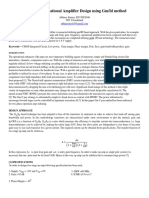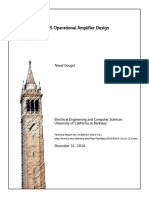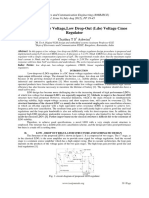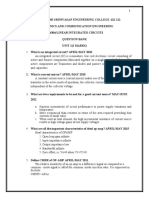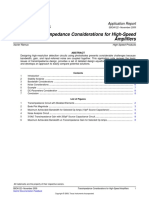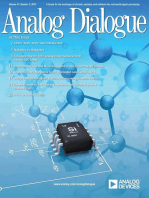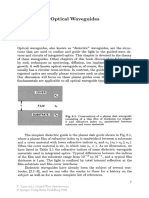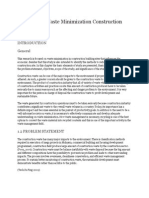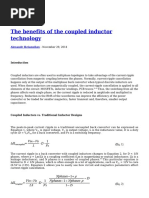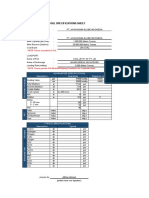0 ratings0% found this document useful (0 votes)
16 viewsDifferential Amp: DR Manish Goswami
Differential Amp: DR Manish Goswami
Uploaded by
vijeta diwanThis document discusses differential amplifiers and provides design guidelines. It begins by defining single-ended and differential signaling, noting advantages of differential signaling like noise immunity. It then discusses circuit analysis and design considerations for differential amplifiers. Key steps in the design process are outlined, such as selecting device sizes to meet gain, bandwidth, input common mode range, and other specifications. An assignment is provided to design a differential amplifier meeting given parameters. Sources used are also cited.
Copyright:
© All Rights Reserved
Available Formats
Download as PPTX, PDF, TXT or read online from Scribd
Differential Amp: DR Manish Goswami
Differential Amp: DR Manish Goswami
Uploaded by
vijeta diwan0 ratings0% found this document useful (0 votes)
16 views20 pagesThis document discusses differential amplifiers and provides design guidelines. It begins by defining single-ended and differential signaling, noting advantages of differential signaling like noise immunity. It then discusses circuit analysis and design considerations for differential amplifiers. Key steps in the design process are outlined, such as selecting device sizes to meet gain, bandwidth, input common mode range, and other specifications. An assignment is provided to design a differential amplifier meeting given parameters. Sources used are also cited.
Original Title
differntial amp
Copyright
© © All Rights Reserved
Available Formats
PPTX, PDF, TXT or read online from Scribd
Share this document
Did you find this document useful?
Is this content inappropriate?
This document discusses differential amplifiers and provides design guidelines. It begins by defining single-ended and differential signaling, noting advantages of differential signaling like noise immunity. It then discusses circuit analysis and design considerations for differential amplifiers. Key steps in the design process are outlined, such as selecting device sizes to meet gain, bandwidth, input common mode range, and other specifications. An assignment is provided to design a differential amplifier meeting given parameters. Sources used are also cited.
Copyright:
© All Rights Reserved
Available Formats
Download as PPTX, PDF, TXT or read online from Scribd
Download as pptx, pdf, or txt
0 ratings0% found this document useful (0 votes)
16 views20 pagesDifferential Amp: DR Manish Goswami
Differential Amp: DR Manish Goswami
Uploaded by
vijeta diwanThis document discusses differential amplifiers and provides design guidelines. It begins by defining single-ended and differential signaling, noting advantages of differential signaling like noise immunity. It then discusses circuit analysis and design considerations for differential amplifiers. Key steps in the design process are outlined, such as selecting device sizes to meet gain, bandwidth, input common mode range, and other specifications. An assignment is provided to design a differential amplifier meeting given parameters. Sources used are also cited.
Copyright:
© All Rights Reserved
Available Formats
Download as PPTX, PDF, TXT or read online from Scribd
Download as pptx, pdf, or txt
You are on page 1of 20
Differential Amp
BY
Dr Manish Goswami
Sunday, April 26, 2020 1
Single-Ended and Differential Operation
• A “single-ended” signal is one that is measured
with respect to a fixed potential while a
differential signal is one that is measured
between two nodes.
• The “center” potential in differential signaling is
called the “common-mode” (CM).
• Advantages of Differentail- Higher immunity to
“environmental” noise in differential operation
as compared to single-ended signaling
Sunday, April 26, 2020 2
• CM rejection also occurs with noisy supply voltages
• The differential circuit is more robust to supply noise
than its single-ended counterpart
• Differential operation is as beneficial for sensitive
signals (“victims”) as for noisy lines (“aggressors”)
• With perfect symmetry, the components coupled
from CK and CC̅K to the signal line cancel each other.
• Differential signaling increases maximum achievable
voltage swings
Sunday, April 26, 2020 3
Circuit & Analysis
Sunday, April 26, 2020 4
Sunday, April 26, 2020 5
Sunday, April 26, 2020 6
Sunday, April 26, 2020 7
Sunday, April 26, 2020 8
Sunday, April 26, 2020 9
Sunday, April 26, 2020 10
Sunday, April 26, 2020 11
Sunday, April 26, 2020 12
• Differential amplifier forms the first stage in
operational amplifier.
• It’s function is to amplify only the difference
between the two signals and reject any
common between them.
• Figure 1 shows typical structure of active load
MOS differential amplifier
Sunday, April 26, 2020 13
vp = vicm + vd vn = vicm−vd
Differential Gain = vout/( vp−vn) = gm(ro2||ro4)
Common mode gain = − 1/ 2gm3ro5
|CMRR| = gm(ro2||ro4)/( 2gm3ro5−1)= 2gm1∗gm3∗ro5(ro2||ro4)
Sunday, April 26, 2020 14
Frequency Response
• The simplified small signal circuit of differential
amplifier is shown Figure 4. The circuit has two
capacitances Cm and CL. Cm is mainly formed
by Cgs3 and Cgs4 but also includes Cgd1,Cdb1
and Cdb3.
• Cm = Cgd1 + Cdb1 + Cdb3 + Cgs3 + Cgs4
Capacitance CL includes Cgd2, Cdb2, Cdb4 and
Cgd4.
• CL = Cgd2 + Cdb2 + Cdb4 + Cgd4
Sunday, April 26, 2020 15
• The transfer function of differential amplifier
is given by
Sunday, April 26, 2020 16
Design of Differential Amplifier
• Specifications might consists of:
• Small signal gain (Av)
• Frequency response for the given load
capacitance (f−3dB)
• Input common mode range
• Slew rate for given load capacitance
• Power dissipation
Sunday, April 26, 2020 17
STEPS FOR DESIGN
• Select I5 based on slew rate specification and Vdd,vss &
Pdiss.
• To meet the given f−3dB calculate the required Ro and
modify the I5
• Select (W L )3,4 to meet the upper ICMR.
VSG3 = VDD −VICMR + Vtn
• Select (W L )1,2 to attain the specified gain.
Av= gm1Ro =gm1 /(gds2 + gds4)
=
• Select (W L )5 to meet the lower ICMR.
Vds5 = VICMR −Vgs
• Repeat the above steps if all design specifications are not
met.
Sunday, April 26, 2020 18
Assisgment-1
• Design a differential amplifier for the following
specifications
• Parameter Value
• Av 50dB
• SR 15V/µs
• f−3dB 300kHz
• ICMRmin 1.7V
• ICMRmax 4.5V
• Pdiss 1.5mW
• CL 3pF
Sunday, April 26, 2020 19
Books Used as Source
• Allen Holberg-
• Razavi
Sunday, April 26, 2020 20
You might also like
- Multiple-Choice Questions: Chapter 49 Nervous SystemsDocument10 pagesMultiple-Choice Questions: Chapter 49 Nervous SystemsTrajce100% (3)
- CRISPR Case StudyDocument5 pagesCRISPR Case StudyKiersten RobertsNo ratings yet
- Two-Stage Operational Amplifier Design Using Gm/Id MethodDocument7 pagesTwo-Stage Operational Amplifier Design Using Gm/Id Methodabhinav kumarNo ratings yet
- Port Tutorial CPWDocument11 pagesPort Tutorial CPWrajgopt88% (16)
- Ethylene Oxide Sterilization Validation ProtocolDocument26 pagesEthylene Oxide Sterilization Validation ProtocolSergio Rodriguez Morales100% (1)
- Two Stage Opamp BerkeleyDocument25 pagesTwo Stage Opamp BerkeleyCircuit CruzNo ratings yet
- Flash ADCDocument15 pagesFlash ADCJagadeep KumarNo ratings yet
- 1.6 Scaling PrinciplesDocument18 pages1.6 Scaling Principlessreemurarik756No ratings yet
- Renamed For Single StageDocument57 pagesRenamed For Single StageAndy RockerNo ratings yet
- CCD CascodeDocument7 pagesCCD CascodeAryan PundNo ratings yet
- Ltspice 04 CS ResDocument29 pagesLtspice 04 CS ResDr. Sampatrao L. PinjareNo ratings yet
- Ecen 607 CMFB-2011Document44 pagesEcen 607 CMFB-2011Girish K NathNo ratings yet
- Design of A Low Voltage, Low Drop-Out (Ldo) Voltage Cmos RegulatorDocument7 pagesDesign of A Low Voltage, Low Drop-Out (Ldo) Voltage Cmos RegulatorSavio SNo ratings yet
- Ece113 Lec14 RF Amplifier DesignDocument60 pagesEce113 Lec14 RF Amplifier Design許耕立No ratings yet
- 6-ECG Circuit-PreparedDocument29 pages6-ECG Circuit-PreparedFarhanNo ratings yet
- 2019S Lec Ch9 CascodeStage&CurrentMirrors RevDocument29 pages2019S Lec Ch9 CascodeStage&CurrentMirrors Revp.비둘기폴더의비밀No ratings yet
- Linear Ic Applications: BY Mr. N. Sri Prakash Assistant Professor Dept. of ECEDocument34 pagesLinear Ic Applications: BY Mr. N. Sri Prakash Assistant Professor Dept. of ECESri Prakash NarayanamNo ratings yet
- Unit 3 Mosfet ScalingDocument25 pagesUnit 3 Mosfet ScalingjoyceNo ratings yet
- Flash AdcDocument15 pagesFlash AdcbittibssiNo ratings yet
- Ie CepDocument11 pagesIe Cepabdul shaggyNo ratings yet
- High Accuracy Impedance Measurements Using 12-Bit Impedance ConvertersDocument6 pagesHigh Accuracy Impedance Measurements Using 12-Bit Impedance Converterschristobal_huntaNo ratings yet
- Analog Integrated Circuits & Technology (EC 305) : Differential Amplifier With Passive Load and Its Detail AnalysisDocument13 pagesAnalog Integrated Circuits & Technology (EC 305) : Differential Amplifier With Passive Load and Its Detail AnalysisAbir HoqueNo ratings yet
- High-Gain Differential Amplifier DesignDocument21 pagesHigh-Gain Differential Amplifier DesignBodhayan PrasadNo ratings yet
- A High Performance CMOS Band - Gap Reference Circuit DesignDocument6 pagesA High Performance CMOS Band - Gap Reference Circuit DesignKhaja Mujeebuddin QuadryNo ratings yet
- BCS Unit IIIDocument34 pagesBCS Unit IIIbtechproject404No ratings yet
- Experiment No:5: Gain, Differential Mode Gain, Gain, Differential Mode Gain, CMRR, Slew Rate Common ModeDocument4 pagesExperiment No:5: Gain, Differential Mode Gain, Gain, Differential Mode Gain, CMRR, Slew Rate Common ModeAyush SahNo ratings yet
- h05 Lecture3Document19 pagesh05 Lecture3tqthang7794No ratings yet
- EEE 312 Lecture8Document7 pagesEEE 312 Lecture8Zeynal Abidin ŞabaşNo ratings yet
- 2Document10 pages2Marcelo OemNo ratings yet
- Module 1-Introduction and Image Parameter MethodDocument83 pagesModule 1-Introduction and Image Parameter MethodTanvi DeoreNo ratings yet
- Ch03 Single Stage AmplifiersDocument85 pagesCh03 Single Stage AmplifiersĐỗ Đức Huy NguyễnNo ratings yet
- EE240 Term Project SPRING 2001: OutlineDocument22 pagesEE240 Term Project SPRING 2001: OutlineArnab Jyoti BaruahNo ratings yet
- Girija Review PDFDocument31 pagesGirija Review PDFGirijambaNo ratings yet
- Lab 4 A Folded-Cascode Operational AmplifierDocument6 pagesLab 4 A Folded-Cascode Operational AmplifierJatinKumarNo ratings yet
- Unit-I: Microwave ComponenetsDocument238 pagesUnit-I: Microwave Componenetspradnya patilNo ratings yet
- Ads 131 M 08Document117 pagesAds 131 M 08Paulo PecegueiroNo ratings yet
- Cascode Amplifier: Exp - No: 5 Date: 20-9-2021Document9 pagesCascode Amplifier: Exp - No: 5 Date: 20-9-2021annambaka satishNo ratings yet
- SESD_lab9-11 (24-25)Document5 pagesSESD_lab9-11 (24-25)Carlos GamioNo ratings yet
- Unit 3 Mosfet ScalingDocument24 pagesUnit 3 Mosfet ScalingjoyceNo ratings yet
- Holberg Folded Cascode DesignDocument45 pagesHolberg Folded Cascode Designsibi11487100% (2)
- Aic Lab Cadence 11 Folded v02Document9 pagesAic Lab Cadence 11 Folded v02Hagar IlbheryNo ratings yet
- Ael Micro-Project: by Abdullah ShaikhDocument14 pagesAel Micro-Project: by Abdullah ShaikhAbdullah shaikh 33No ratings yet
- Tnd389 D EmcDocument70 pagesTnd389 D EmcjumatteoNo ratings yet
- Multiplying Dacs: Flexible Building BlocksDocument8 pagesMultiplying Dacs: Flexible Building BlocksLucas McCauleyNo ratings yet
- LMH6550 Differential, High Speed Op Amp: R R V V ADocument25 pagesLMH6550 Differential, High Speed Op Amp: R R V V AJavier Felipe AlvaradoNo ratings yet
- Gyrator IIDocument17 pagesGyrator IIramesh krishnaNo ratings yet
- C3.0 Operational Amplifiers II: Jeng-Han TsaiDocument12 pagesC3.0 Operational Amplifiers II: Jeng-Han Tsailinux14No ratings yet
- Chapter 5 HPCN Updated 02-06-2021Document64 pagesChapter 5 HPCN Updated 02-06-2021muluken getenetNo ratings yet
- Irjet V4i5125 PDFDocument5 pagesIrjet V4i5125 PDFAnonymous plQ7aHUNo ratings yet
- Department of Electrical and Systems Engineering: MOSFET Amplifier Mini ProjectDocument7 pagesDepartment of Electrical and Systems Engineering: MOSFET Amplifier Mini ProjectsadfaNo ratings yet
- EE 230 - Analog Lab - 2021-22/I (Autumn) Experiment 6: Opamp AmplifiersDocument6 pagesEE 230 - Analog Lab - 2021-22/I (Autumn) Experiment 6: Opamp AmplifiersSruthiNo ratings yet
- The CRT-Based OscilloscopeDocument55 pagesThe CRT-Based OscilloscopeJuNo ratings yet
- Antenna project fileDocument11 pagesAntenna project filemishranitesh25072004No ratings yet
- MAX22530 Isolated ADCDocument37 pagesMAX22530 Isolated ADCRoy ChaiNo ratings yet
- Complete Front End Solutions For Weigh Scales PDFDocument5 pagesComplete Front End Solutions For Weigh Scales PDFmahamd saiedNo ratings yet
- Ec8361-Adc Lab ManualDocument118 pagesEc8361-Adc Lab ManualmuminthajNo ratings yet
- Data Sheet c78-727600Document17 pagesData Sheet c78-727600Pamela Sánchez RamosNo ratings yet
- AMIS-30660 High Speed CAN Transceiver: Description Marking DiagramDocument10 pagesAMIS-30660 High Speed CAN Transceiver: Description Marking DiagramНаталія ЛіськевичNo ratings yet
- Unit 4 PDFDocument23 pagesUnit 4 PDFHarsha Vardhan ReddyNo ratings yet
- Differential Amplifier: Mrs.V.Srirenganachiyar, Ap/Ece Ramco Institute of Technology Academic Year:2017-2018 (Odd)Document13 pagesDifferential Amplifier: Mrs.V.Srirenganachiyar, Ap/Ece Ramco Institute of Technology Academic Year:2017-2018 (Odd)Hitlar MamaNo ratings yet
- IJCRT2007590Document6 pagesIJCRT2007590Deepanshi R. KumarNo ratings yet
- EC6404 Linear Integrated CircuitsDocument65 pagesEC6404 Linear Integrated CircuitsrajkumarsacNo ratings yet
- Transimpedance Considerations For High-Speed Amplifiers: Application ReportDocument9 pagesTransimpedance Considerations For High-Speed Amplifiers: Application ReportRajasekar PanneerselvamNo ratings yet
- ComplexDocument14 pagesComplexvijeta diwanNo ratings yet
- Electromagnetic Boundaries With Pec PMCDocument7 pagesElectromagnetic Boundaries With Pec PMCvijeta diwanNo ratings yet
- Compound Interest QuizDocument16 pagesCompound Interest Quizvijeta diwanNo ratings yet
- Open BookDocument8 pagesOpen Bookvijeta diwanNo ratings yet
- A Substrate Integrated Gap Waveguide Based Wideband 3-dB Coupler For 5G ApplicationsDocument9 pagesA Substrate Integrated Gap Waveguide Based Wideband 3-dB Coupler For 5G Applicationsvijeta diwanNo ratings yet
- IET Microwaves Antenna Prop - 2017 - Zheng - Metamaterial Based Patch Antenna With Wideband RCS Reduction and GainDocument7 pagesIET Microwaves Antenna Prop - 2017 - Zheng - Metamaterial Based Patch Antenna With Wideband RCS Reduction and Gainvijeta diwanNo ratings yet
- Pre & Complex EnvelopeDocument11 pagesPre & Complex Envelopevijeta diwanNo ratings yet
- Wave Equations For Step Index FiberDocument21 pagesWave Equations For Step Index Fibervijeta diwanNo ratings yet
- Theory of Optical Waveguides: With 32 FiguresDocument82 pagesTheory of Optical Waveguides: With 32 Figuresvijeta diwanNo ratings yet
- Channel CapacityDocument15 pagesChannel Capacityvijeta diwan100% (1)
- Wireless Channel ChallengeDocument4 pagesWireless Channel Challengevijeta diwanNo ratings yet
- Hardware (Analog Components) Vs Software Radio (Reconfigurable Processors)Document13 pagesHardware (Analog Components) Vs Software Radio (Reconfigurable Processors)vijeta diwanNo ratings yet
- Channel ImpairmentsDocument5 pagesChannel Impairmentsvijeta diwanNo ratings yet
- Jackhammer: Efficient Rowhammer On Heterogeneous Fpga-Cpu PlatformsDocument16 pagesJackhammer: Efficient Rowhammer On Heterogeneous Fpga-Cpu Platformsvijeta diwanNo ratings yet
- Information Leakage Attacks On Emerging Non-Volatile Memory and CountermeasuresDocument6 pagesInformation Leakage Attacks On Emerging Non-Volatile Memory and Countermeasuresvijeta diwanNo ratings yet
- Rowhammer Injection MethodologyDocument10 pagesRowhammer Injection Methodologyvijeta diwanNo ratings yet
- Rowhammer Attack On PufDocument6 pagesRowhammer Attack On Pufvijeta diwanNo ratings yet
- Testability Measures SCOAP BushnellDocument33 pagesTestability Measures SCOAP Bushnellvijeta diwanNo ratings yet
- What Is Place Value - Maths Definition & Examples - TwinklDocument5 pagesWhat Is Place Value - Maths Definition & Examples - Twinkljayvine93No ratings yet
- K L University Freshman Engineering Department: A Project Based Lab Report On Hotel Management SystemDocument21 pagesK L University Freshman Engineering Department: A Project Based Lab Report On Hotel Management SystemMahima Chowdary100% (1)
- ESP8266 Weather StationDocument14 pagesESP8266 Weather StationVELAKITONo ratings yet
- Toshiba E-Studio 477S-527S Parts ManualDocument38 pagesToshiba E-Studio 477S-527S Parts ManualJamesNo ratings yet
- Sample 7390Document11 pagesSample 7390avianbuNo ratings yet
- Electrical CommissioningDocument18 pagesElectrical Commissioningoadipphone7031100% (1)
- Fault & Event Tree Analysis: BY Nitesh M. DongareDocument34 pagesFault & Event Tree Analysis: BY Nitesh M. DongarejsembiringNo ratings yet
- Ferguson Smoke Gets in Your EyesDocument20 pagesFerguson Smoke Gets in Your EyesfefeNo ratings yet
- Listening & StrucutreDocument8 pagesListening & StrucutreFajrin ErwinNo ratings yet
- Reddy, K. Venkata.-Textbook of Engineering Drawing, Second Edition-BS Publications (2008)Document10 pagesReddy, K. Venkata.-Textbook of Engineering Drawing, Second Edition-BS Publications (2008)Damodar ReddyNo ratings yet
- How To Reclaim The Sovereignty of Your Mind - Humans Are Free (Humans Are Free) (Z-Library)Document5 pagesHow To Reclaim The Sovereignty of Your Mind - Humans Are Free (Humans Are Free) (Z-Library)sarapmaria97No ratings yet
- Split Type Air Conditioners (Cassette Type - Non Inverter)Document5 pagesSplit Type Air Conditioners (Cassette Type - Non Inverter)Sarim ShujaNo ratings yet
- 1 s2.0 S0360544223024283 MainDocument13 pages1 s2.0 S0360544223024283 MainRachid BendaoudNo ratings yet
- P5 - Fraction Word Problems 1Document3 pagesP5 - Fraction Word Problems 1olgaNo ratings yet
- Fundamentals of Management AssignmentDocument2 pagesFundamentals of Management Assignmentfathimaniyas017No ratings yet
- Waste Minimization On Construction SitesDocument49 pagesWaste Minimization On Construction Siteskens247No ratings yet
- L01 Text As Connected Discourse DLPDocument6 pagesL01 Text As Connected Discourse DLPJhenjeric OfficialNo ratings yet
- Pantone Black C 3.:, DT8S (WQP8-3806) BekoDocument65 pagesPantone Black C 3.:, DT8S (WQP8-3806) Bekosai prakashNo ratings yet
- The Benefits of The Coupled Inductor TechnologyDocument10 pagesThe Benefits of The Coupled Inductor Technologyaarumugam_rajendranNo ratings yet
- Y2t3ceglgy20 - Geology For EngineersDocument6 pagesY2t3ceglgy20 - Geology For EngineersClifford Anjelo FaderangaNo ratings yet
- Numercy Assessment 2022 GuidelinesDocument9 pagesNumercy Assessment 2022 GuidelinesArlene PradoNo ratings yet
- Coal Specs Sheet GAR 6400Document2 pagesCoal Specs Sheet GAR 6400Adhitya AchmadNo ratings yet
- Agile Sample QuestionsDocument2 pagesAgile Sample Questionscrmreddy100% (1)
- Maximizing The Sharpe RatioDocument3 pagesMaximizing The Sharpe RatioDat TranNo ratings yet
- Erasmus Mundus 2016 Masters Scholarship NetworkDocument9 pagesErasmus Mundus 2016 Masters Scholarship NetworkTauqeer AhmedNo ratings yet
- Dental Informatics PlusDocument1 pageDental Informatics PlusNagendra TyagiNo ratings yet
- Tech Eng 01 Mecha Eng Prof - 2023Document32 pagesTech Eng 01 Mecha Eng Prof - 2023ilyasorhanli.9427No ratings yet


